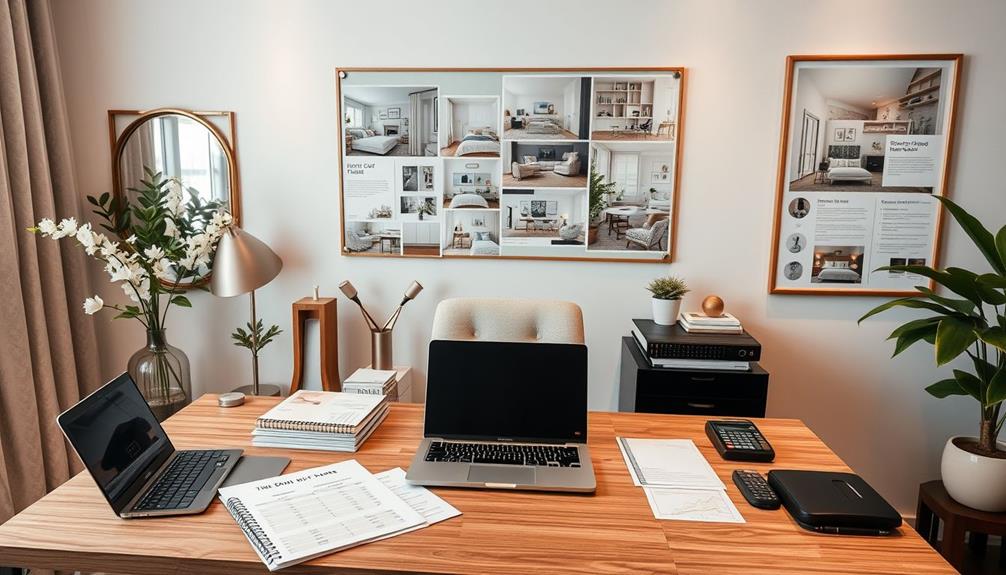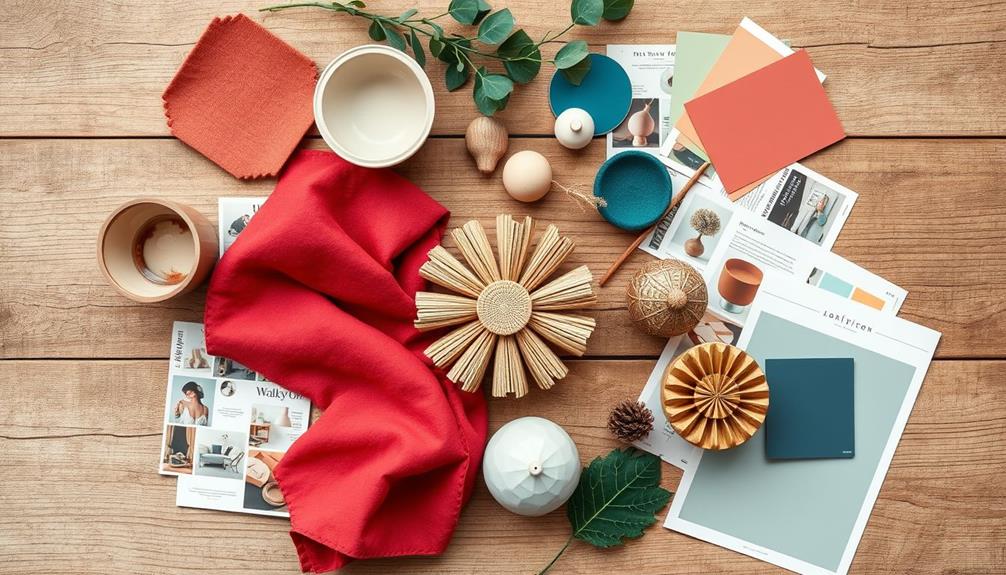To sell your interior design services, start by understanding your clients' needs and preferences. Communicate the unique value of your design solutions, emphasizing how they enhance their space. Build trust through genuine connections and transparency about costs. Establish clear pricing strategies while overcoming any pricing fears you or your clients may have. Tailor your services based on specific client situations and leverage networking opportunities for more connections. Consistent follow-ups can nurture leads, while showcasing success stories helps illustrate your expertise. As you refine these strategies, you'll discover even more effective ways to attract and retain clients.
Key Takeaways
- Understand client needs through detailed questionnaires to tailor design solutions effectively.
- Communicate the value of your services by sharing success stories and transparent cost breakdowns.
- Build trust with clients by fostering genuine connections and maintaining open communication.
- Implement transparent pricing strategies and educate clients on industry norms to justify fees.
- Showcase past projects with case studies and testimonials to illustrate the impact of your design work.
Understand Client Needs

To effectively sell your interior design services, you need to prioritize understanding your clients' needs. Start by asking questions about how they intend to use each space. This helps you tailor design solutions that fit their specific lifestyle requirements. Additionally, make sure to inquire about their preferred aesthetic and any specific design elements they hope to incorporate. This will allow you to create a cohesive and personalized design plan that resonates with your clients. Furthermore, when starting an interior design business, it’s essential to build trust and establish a strong rapport with your clients. This will not only help you secure their business but also lead to potential referrals and repeat customers.
Don't forget to gather information on any special considerations, like mobility issues or cooking habits, to guarantee your designs are practical and accommodating.
Discuss potential future changes in their lives, such as children leaving home or aging considerations. By doing this, you can create adaptable spaces that remain functional over time.
Utilizing detailed questionnaires can streamline this information-gathering process, guaranteeing you capture all essential aspects of the client's vision and requirements before starting the design.
Communicate Value Effectively

Communicating the value of your interior design services is essential for attracting and retaining clients. To sell your services effectively, you need to clearly articulate the intangible benefits of quality design, such as enhanced brand identity and increased customer engagement.
When clients understand these advantages, they're more likely to appreciate the added value you bring.
Educate your clients about the correlation between financial investment and project engagement. Emphasize that those who invest more tend to be more involved and satisfied with the outcomes.
This approach helps them connect the dots between cost and quality.
Utilize detailed breakdowns of costs in your proposals. This transparency fosters understanding and allows clients to see the worth of your expertise rather than just the price tag.
Sharing success stories or case studies can also reinforce the effectiveness of your design services, showcasing how you've positively impacted previous clients.
Establish Trust and Relationships

Establishing trust and building relationships with clients is fundamental for your interior design success. Fostering genuine connections with potential clients starts with active listening. Understand their needs and preferences; this not only enhances trust but also increases your chances of securing projects.
In addition, understanding how personal attributes, such as astrological compatibility, can influence client relationships may provide deeper insights into their preferences. Attend local events and join networking groups to meet new individuals, which helps you build long-term relationships that are essential for client retention and referrals.
Position yourself as a trusted authority in your field by sharing valuable insights and offering free design advice or workshops. This approach fosters a sense of reliability among potential clients.
Transparency in communication is critical; make certain to clearly discuss project scopes and fees to establish trust and guarantee mutual understanding.
Additionally, don't underestimate the power of regular follow-ups and consistent engagement with prospects. This illustrates your commitment and appreciation for their time, further solidifying the designer-client relationship.
When potential clients feel valued and understood, they're more likely to choose you for their interior design needs. By prioritizing trust and relationships, you pave the way for lasting success in your business.
Set Clear Pricing Strategies

To effectively set clear pricing strategies, you need to establish transparent pricing models that clients can easily understand.
Communicating the value of your services is essential, as it helps clients recognize what they're paying for and why it matters.
Establish Transparent Pricing Models
When it comes to pricing your interior design services, clarity is key. Establishing transparent pricing models helps build trust with your clients. When you communicate your pricing structures clearly, you manage their expectations and reduce the risk of misunderstandings about costs.
Consider charging for initial consultations; this sets a precedent that your services are valuable and reinforces the idea that high fees often correlate with high talent and quality. Clients appreciate a thorough suite of services that cater to their specific needs, which can further justify your pricing strategy innovative spaces.
Providing detailed breakdowns of costs can further educate your clients on the value of your design expertise. This approach helps them understand the investment required for quality outcomes and helps avoid unrealistic demands.
Implementing a cost-plus pricing model can also be effective if structured correctly. This way, clients can see the value in your services without feeling overcharged.
Regularly reviewing and adjusting your pricing strategies based on market trends and client feedback will enhance your competitiveness. By staying adaptable, you guarantee that your services remain perceived as valuable.
In the end, transparent pricing models not only help you sell interior design effectively but also foster a positive client relationship built on trust and understanding.
Communicate Value Effectively
In today's competitive market, effectively communicating the value of your interior design services is essential for attracting and retaining clients. To do this, establish a clear pricing strategy that manages client expectations. Transparency in costs fosters trust and respect in your designer-client relationship, making it easier to sell your interior design.
Incorporating elements like neutral color palettes and natural materials in your designs can showcase your expertise and elevate perceived value.
Consider charging for initial consultations. This sets a precedent for valuing your services and reinforces your expertise, which enhances clients' perception of your pricing. When you provide detailed breakdowns of costs, clients can better understand the value of your design services, reducing misconceptions and unrealistic demands.
Implementing a cost-plus pricing model can also guarantee you're compensated fairly while clarifying how costs are calculated. This approach mitigates client confusion and helps you communicate value effectively.
Educate Clients on Costs
Educating clients about costs is essential for establishing clear pricing strategies that reflect the value of your interior design services. When you set expectations right from the start, such as charging for initial consultations, clients understand that professional design work requires a financial investment. This transparency builds trust, as detailed breakdowns of costs can dispel misconceptions and highlight the worth of your expertise.
As you educate clients on costs, emphasize industry standards and the tangible benefits of quality design. This approach can shift their perception of expenses from burdensome to an investment in their home or business.
Avoid undercharging; it not only protects your perceived value but also encourages clients to take projects seriously, leading to better collaboration and satisfaction.
Consider implementing a cost-plus pricing model. This strategy guarantees fair compensation for your work while helping clients grasp the rationale behind project costs.
Overcome Limiting Beliefs

It's time to tackle those pricing anxieties that hold you back.
By recognizing your true worth and addressing limiting beliefs, you can cultivate the confidence needed to set appropriate fees for your services.
Pricing Anxiety Solutions
Pricing anxiety can create a significant barrier for interior designers, hindering their ability to charge what their services truly deserve. To overcome this, it's crucial to educate yourself on industry standards and develop a strong sense of self-worth. Recognizing your value allows you to set fees that reflect your expertise.
Consider these strategies to alleviate pricing anxiety:
| Strategy | Description | Benefits |
|---|---|---|
| Education | Learn about industry pricing norms | Justify fees with confidence |
| Mentorship | Seek guidance from experienced designers | Shift mindset on value |
| Wealth Mindset Resources | Explore books like "The Prosperity Bible" | Empower financial confidence |
| Peer Support Network | Build relationships with fellow designers | Share challenges and solutions |
Cultivating Self-Worth
To break free from limiting beliefs around your worth as an interior designer, you need to recognize the connection between self-esteem and the prices you charge. Developing a strong sense of self-worth is essential.
Clients often equate high fees with high talent and quality, so when you undervalue yourself, you risk losing potential clients who seek premium services.
Addressing limiting beliefs about pricing can greatly impact your business success. Take time to explore resources like "The Prosperity Bible," which can help cultivate a wealth mindset.
Personal growth in financial confidence not only enhances your self-worth but also boosts your overall business performance.
Consider seeking mentorship to navigate pricing anxiety. A supportive network can empower you to value your work and set appropriate fees.
Tailor Your Services

Tailoring your interior design services to meet the unique needs of each client can set you apart in a competitive market. By addressing specific client problems or life events, like moving into a new home or celebrating a milestone, you enhance the appeal of your offerings.
Start by conducting thorough research on potential clients to customize your outreach. This guarantees your services align with their unique preferences. Incorporating a focus on innovation and design excellence can further elevate your proposals, showcasing your commitment to enhancing both functional and aesthetic aspects of spaces.
Emphasizing the functional benefits of your design solutions, such as improved daily efficiency or increased property value, provides clear justification for your services. When you develop relatable sales messaging that mirrors your clients' experiences and desires, you foster emotional connections, making your services feel more relevant and necessary.
Showcase your capability to meet diverse client needs by utilizing project captions and case studies that highlight successful tailored designs. This not only demonstrates your expertise but also builds trust with potential clients.
Ultimately, when you tailor your services to resonate with your audience, you create a compelling narrative that makes your interior design services irresistible.
Leverage Networking Opportunities

Networking opportunities are essential for growing your interior design business and connecting with potential clients. Attending local events and joining networking groups can help you build genuine connections. Personal interactions often lead to more meaningful business relationships and referrals. Utilize social media platforms like LinkedIn and Instagram to maintain those connections and engage with potential clients.
Here's how to leverage these opportunities effectively:
| Strategy | Description |
|---|---|
| Attend Local Events | Meet potential clients face-to-face. |
| Join Networking Groups | Connect with like-minded professionals. |
| Practice Active Listening | Understand client needs for better rapport. |
| Organize Workshops | Showcase your expertise and engage prospects. |
Follow Up Consistently

Consistent follow-ups are essential for turning potential leads into loyal clients in the interior design industry.
By maintaining engagement with prospects, you can greatly boost your conversion rates. In fact, consistent follow-ups can increase lead conversion rates by up to 80%.
Here's how you can effectively follow up:
- Establish a Schedule: Set up weekly or bi-weekly check-ins to keep your services top-of-mind without overwhelming prospects.
- Personalize Your Messages: Tailor your follow-up messages based on previous interactions to enhance connections and show genuine interest in their needs.
- Use Multiple Channels: Engage with potential clients through various methods—emails, phone calls, or social media messages—to cater to different preferences.
- Address Questions: Following up after initial meetings not only reinforces discussions but also gives you a chance to address any lingering questions or concerns.
Showcase Success Stories

After you've established a solid follow-up routine, it's time to showcase your successes. Highlighting case studies of past projects where your design services transformed clients' living spaces can greatly help you sell. Use before-and-after photos to visually demonstrate the dramatic impact of your work.
Incorporate testimonials from satisfied clients detailing their positive experiences and the tangible benefits they gained from your services. This enhances your credibility and helps potential clients envision their own success.
Metrics, like increased property value or improved functionality, can quantify your design implementations' success, making the results measurable and compelling.
Additionally, create engaging content, such as video walkthroughs of completed projects, to provide an immersive experience that illustrates your quality and creativity.
Foster a narrative around each success story that emphasizes your problem-solving abilities and customization options. By demonstrating your capability to tailor services to meet diverse client needs, you'll not only showcase success stories but also build trust and rapport with prospective clients.
Showcasing these achievements effectively positions you as the go-to designer for their projects, ultimately helping you sell your services with confidence.
Conclusion
In the vibrant tapestry of interior design, every thread you weave matters. By understanding your clients' needs and showcasing your unique value, you create a masterpiece that resonates with their vision. Building trust is like nurturing a garden— it flourishes with care and attention. Embrace networking as your canvas, and let your success stories shine like stars in the night sky. With each step, you're not just selling a service; you're inviting clients to transform their spaces into homes.








